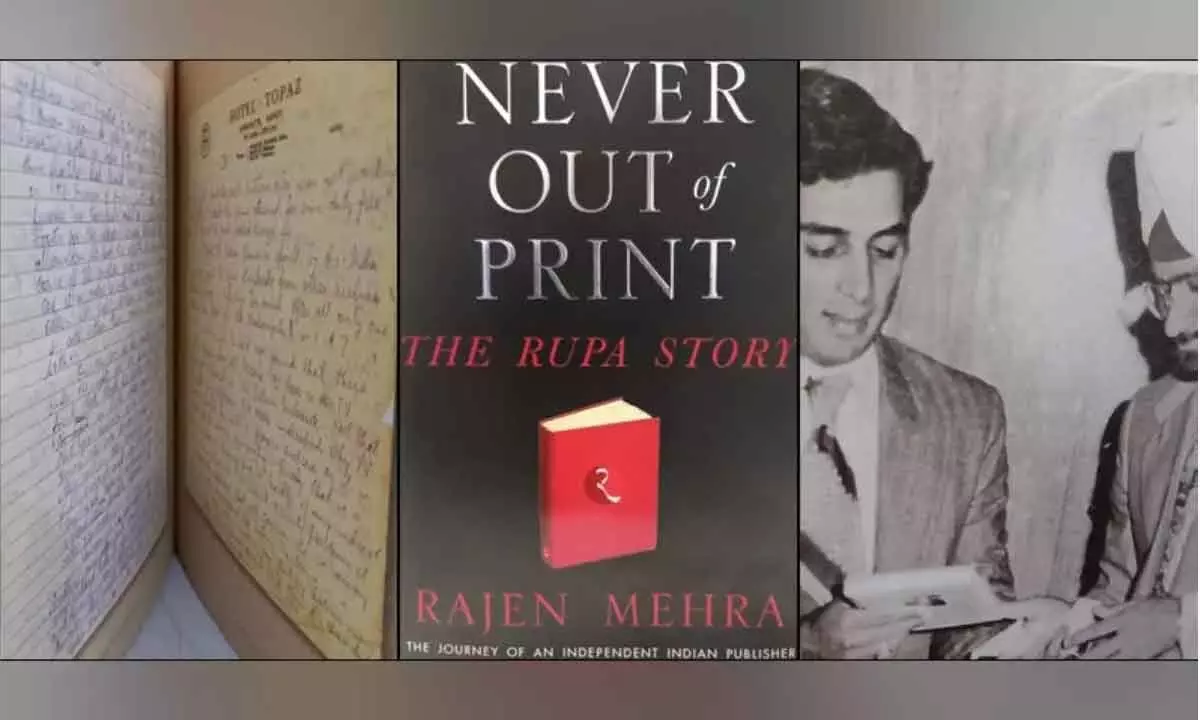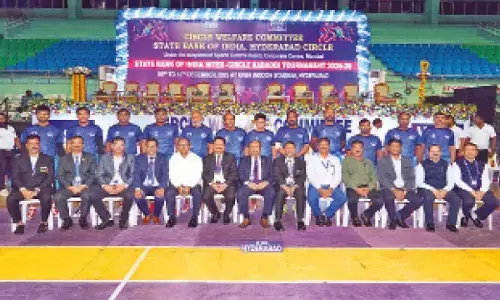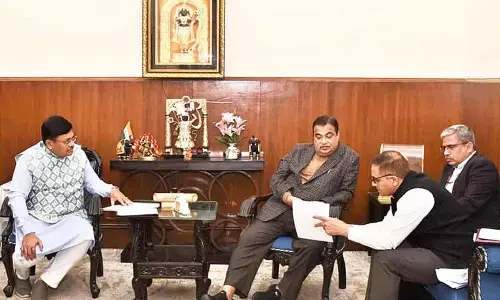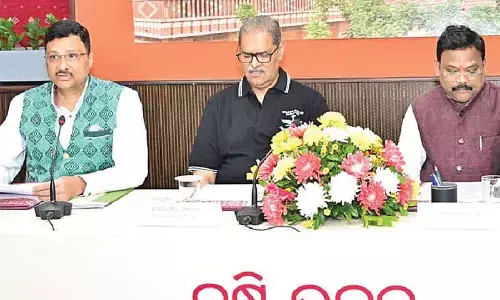How a newbie Gavaskar straight drove a publishing record
Share :

Very few independent publishers have achieved so much in their lifetime with the world knowing so little about them as the unassuming, soft-spoken Rajen Mehra.
The Chairman of Rupa Publications and Aleph Book Company, however, has finally narrated the story of his star-studded life within the covers of a book: “Never Out of Print - The Rupa Story”. It is teeming with stories of the bestsellers he commissioned and the writing stars he created -- not the least of them being Ruskin Bond and Chetan Bhagat.
Rajen Mehra single-handedly scripted a home-grown publishing success story by building on his uncle Daudayal Mehra’s humble beginnings, dating back to the time when he sold books, mainly dictionaries, from a pavement in College Street, Kolkata, in 1936, into one of India’s top publishing houses, whose authors’ list ranges from leaders spanning generations and ideologies, from Acharya J.B. Kripalani, fiery Communist MP Mohit Sen and the country’s eighth President R. Venkataraman to L.K. Advani and Jaswant Singh, to Titans of their age, from Maharani Gayatri Devi and J.R.D. Tata to Don Bradman.
Among Mehra’s many claims to fame is the first-ever biography of Indira Gandhi by Ela Sen with a cover embellished by the bold brush strokes of Satyajit Ray (yes, the auteur was an artist too).
In the excerpts that follow from the book, Mehra shares the comedy of errors-style story of how he got the rights to publish Sunil Gavaskar’s autobiography in 1976 and rolled it out in 121 days. The book, “Sunny Days”, began with tepid sales but a century by the Little Master at the Wankhede Stadium, the last of India’s disastrous home Test series against England, sent the sales flying into stratosphere. It hasn’t stopped selling since then -- and is now into its 31st reprint, making it a record of sorts in the history of sports publishing.
Excerpts from Rajen Mehra’s “Never Out of Print - The Rupa Story”:
‘Niche paan ki dukaan, upar gori ka makaan’ was the song from the movie “Silsila” by Yash Chopra, starring Amitabh Bachchan and Shashi Kapoor. I adapted that song to fit someone I idolised. My version of that story went: ‘Niche paan ki dukaan, upar mere idol ka makaan’. This was because the Rupa office in Bombay was in the Konark building, which also housed the office of the Little Master, Sunil Gavaskar.
When Rupa published “Sunny Days”, I never anticipated that the sun would never set on the title. I signed off on its first print run in 1976 and my son, Kapish, signed off on its 31st reprint edition in 2023. To date, it is the longest running sports autobiography we have published and, to my knowledge, no other cricket autobiography has been in print for that long. It hasn’t been out of print in 46 years, and its longevity and sales numbers are quite likely a record for any cricket book published anywhere in the world.
Just like Gavaskar’s time on the cricket pitch, “Sunny Days” is a delight and we found it enormously fulfilling to publish it. However, its journey began with a little confusion just as two batsmen at the crease often are prone to misunderstandings that could lead to a run out.
Our confusion pertained to a meeting venue, which had been a wrong call on my part. But, thankfully, our innings went on. On 28 August 1976, my friend, the renowned Bombay-based media baron, Khalid Ansari, the owner of ‘Sportsweek’ and ‘Mid-Day’ (his father had started the Urdu daily ‘Inquilab’), and Sharad Kotnis, who was the associated editor of ‘Sportsweek’, arranged an appointment with Gavaskar for me. ...
We were to meet at the Taj at Apollo Bunder. I thought the venue was the coffee shop at the Taj while Gavaskar thought it was the Sea Lounge. Mobile phones were still 20 years away and it took us some time to sort out the confusion. Thankfully, when I finally rushed to the correct venue, Gavaskar was still waiting. Once the adrenaline rush subsided, I was able to focus on what he was saying.
Famously, Gavaskar played with a straight bat, and there was no exception to this practice here either -- he told me without dissembling that he’d had offers from A.H. Wheeler and Symonds. I appreciated his honesty and presented my offer. He would get a percentage of the book’s sales royalty and there would be no advance. To my astonishment and relief, the rising star of Indian cricket agreed to sign up with Rupa.
He had just one condition -- the book should be out on 16 December, just as India were to start its home Test series against England. This meant that I had three and a half months to transform the manuscript into a book. These were the times of rather primitive printing and communications technology (as compared to today) -- no computerised typesetting, no latest digital versions of offset printing, no mobile phones, no WhatsApp.
But, if Rupa had to make its presence felt as a serious publisher of sports books, it had to accept this challenge. Ajit Wadekar’s “My Cricketing Years” by Vikas Publishing House had just been published and was a bestseller already. The pressure to match the sales of “My Cricketing Years” was immense.
With the manuscript in my hand, I said goodbye to my idol, assuring him that in three months he would add ‘author’ to his biodata. I left the hotel and headed straight to the YMCA near Maratha Mandir, where I was staying. The sky was overcast and it soon started pouring. It rained incessantly till the streets were flooded and all the taxis seemed to have magically disappeared. And there I was, clinching the unprotected manuscript by Gavaskar -- the only copy on the planet. Something had to be done quickly to prevent it from getting wet.
A grocery store owner nearby came to my rescue. I got a plastic bag from his shop and wrapped my prized possession in it. Holding a manuscript in one hand and my shoes in the other (I had taken them off so I could feel my way along the flood street with my bare feet -- the city was notorious for its open manhole into which unwary pedestrians could fall), I crept along and somehow reached the lobby of the YMCA with my precious cargo intact.
Having changed out of my wet clothes, I ordered a hot coffee from room service and settled down to read the manuscript. But before I began reading, I turned on the radio and heard
the announcement that a singer many loved, Mukesh, had just passed away in
New York.
Memories of my tuneless singing of Mukesh’s songs in the office canteen flooded my mind; I also recalled Gavaskar telling me how he had used a Mukesh song to spur on the spinner B.S. Chandrashekhar to great heights when he had been bowling in a cricket match in Calcutta. Apparently, no sooner had he sung a Mukesh song that the spinner bowled out the batsman in his next ball.
It was a strange sensation to be reading the manuscript of the finest cricket book I would ever publish while listening to the songs of the immortal singer playing on the radio...
On 16 December 1976, we released “Sunny Days”, just a day before the Test series with England started at home. And what a beating the home team took. We lost the first Test, the second and the third. The fourth was won by India, but so
far, my author had been mild with the bat. Naturally, the response to the book was lukewarm. The final rubber at Bombay was drawn but Gavaskar shone with his
bat. A century against his name on the Wankhede Stadium scoreboard set the cash registers ringing for “Sunny Days”.
On the field, the cricketer was scripting history and in the stores, he and Rupa were smashing sales records. So, how did “Sunny Days” prove to be the monster hit it became? Gavaskar’s profile notwithstanding, I believe it succeeded because it was a no-holds-barred account of the life of one of our greatest cricketers ever.
The Little Master tells us with wit and honesty the key details of his life. How the baby (Gavaskar) was switched at birth in the hospital ward with the newborn of a fisherman’s family, but was luckily restored to his rightful place by an eagle-eyed uncle; how he almost broke his mother’s nose with a mighty hit; how he was, at times, booed by the crowd when he was playing domestic cricket, as his uncle happened to be a selector! And then at the age of 21, at Port of Spain, West Indies, Gavaskar burst upon the international cricket scene with the sound of thunder.


















